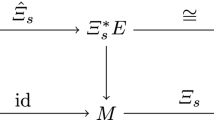Abstract
Estimates are obtained for time intervals containing a zero of the Pauli–Jordan–Dirac anticommutator in a discrete representation in the one- and three-dimensional cases.
Similar content being viewed by others
REFERENCES
P. A. M. Dirac, “The quantum theory of the emission and absorption of radiation,” Proc. R. Soc. London Ser. A 114 (767), 243–265 (1927).
P. A. M. Dirac, “Discussion of the infinite distribution of electrons in the theory of the positron,” Math. Proc. Cambridge Philos. Soc. 30 (2), 150–163 (1934).
P. Jordan and W. Pauli, “Zur Quantenelektrodynamik ladungsfreier Felder,” Z. Phys. 47, 151–173 (1928).
L. I. Schiff, Quantum Mechanics, 2nd ed. (McGraw-Hill, New York, 1955).
E. A. Karatsuba, “Zeros and points of discontinuity of the commutator function of the free Dirac field,” J. Phys.: Conf. Ser. 128, 012015 (2008).
E. A. Karatsuba, “The commutator function of the free Dirac field in the discrete representation and its zeros,” Pac. J. Appl. Math. 1 (2), 37–55 (2008).
N. N. Bogoliubov and D. V. Shirkov, Introduction to the Theory of Quantized Fields, 3rd ed. (Wiley, New York, 1980).
P. A. M. Dirac, “On the theory of quantum mechanics,” Proc. R. Soc. London Ser. A 112, 661–677 (1926).
P. A. M. Dirac, “On the annihilation of electrons and protons,” Math. Proc. Cambridge Philos. Soc. 26, 361–375 (1930).
E. Fermi, “Quantum theory of radiation,” Rev. Mod. Phys. 4, 87–132 (1932).
W. Pauli, “The connection between spin and statistics,” Phys. Rev. 58, 716–722 (1940).
W. Pauli, “Relativistic field theories of elementary particles,” Rev. Mod. Phys. 13, 203–232 (1941).
J. Schwinger, “Quantum electrodynamics: I. A covariant formulation,” Phys. Rev. 74, 1439–1461 (1948).
F. Mercati and M. Sergola, “Pauli–Jordan function and scalar field quantization in κ-Minkowski noncommutative spacetime,” Phys. Rev. D 98, 045017 (2018).
D. Liu, F. Chen, S. Chen, and N. Ma, “Calculating Pauli–Jordan function,” Eur. J. Phys. 41 (3), 035406 (2020).
A. A. Karatsuba and E. A. Karatsuba, “Physical mathematics in number theory,” Funct. Anal. Other Math. 3 (2), 113–125 (2011).
Funding
This work was supported by ongoing institutional funding. No additional grants to carry out or direct this particular research were obtained.
Author information
Authors and Affiliations
Corresponding author
Ethics declarations
The author of this work declares that she has no conflicts of interest.
Additional information
Translated by I. Ruzanova
Publisher’s Note.
Pleiades Publishing remains neutral with regard to jurisdictional claims in published maps and institutional affiliations.
Rights and permissions
About this article
Cite this article
Karatsuba, E.A. Dirac Electron Free Field Anticommutator and Its Zeros on Time Intervals. Dokl. Math. 108, 363–368 (2023). https://doi.org/10.1134/S1064562423701247
Received:
Revised:
Accepted:
Published:
Issue Date:
DOI: https://doi.org/10.1134/S1064562423701247



